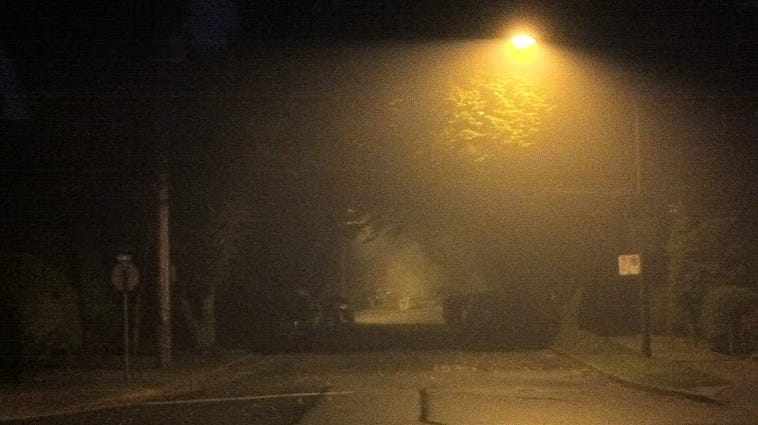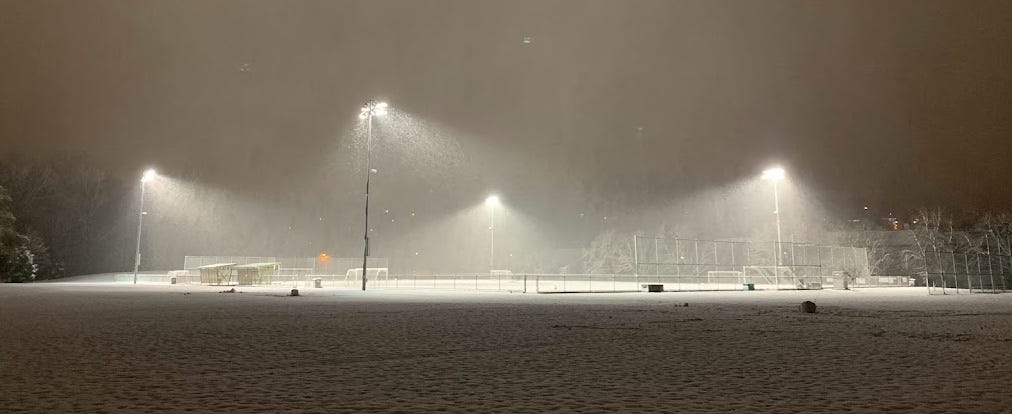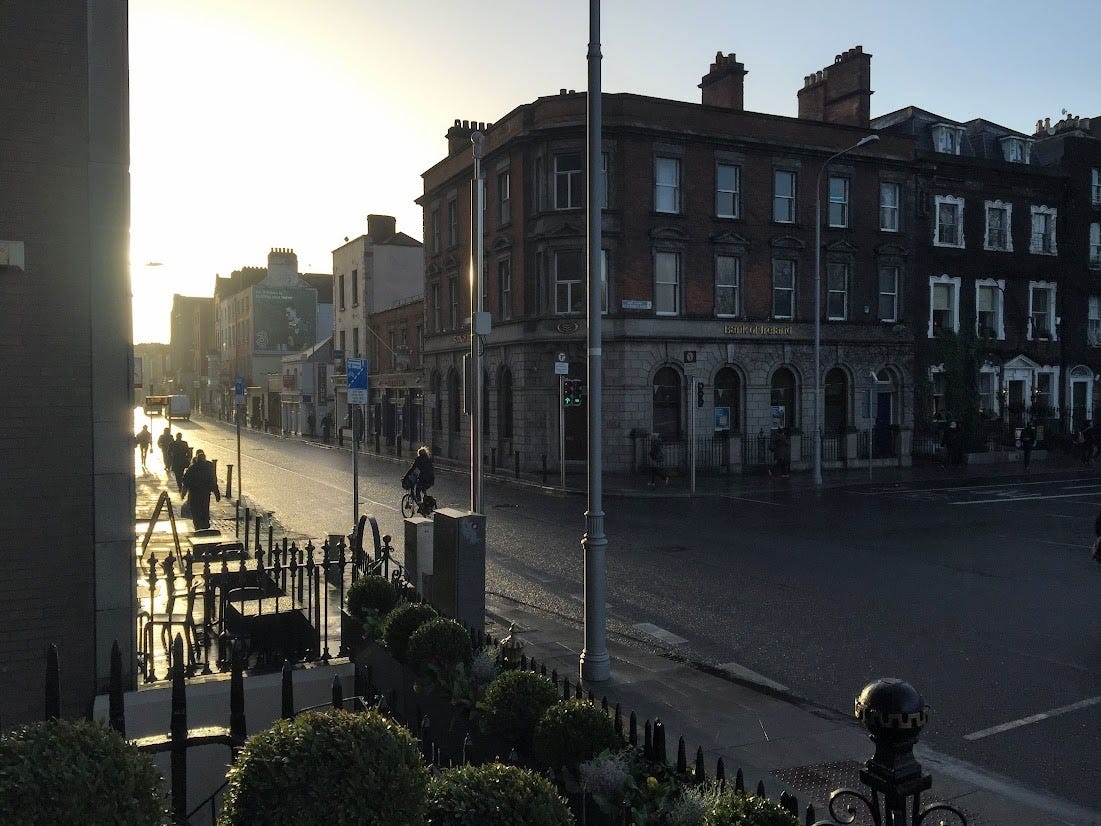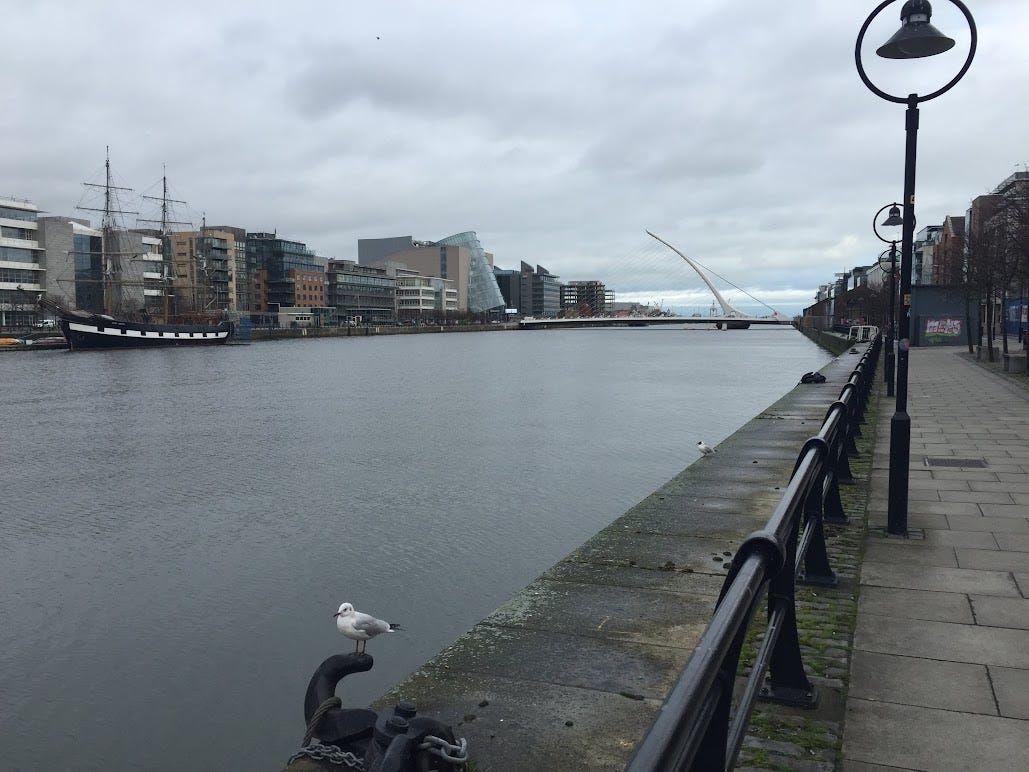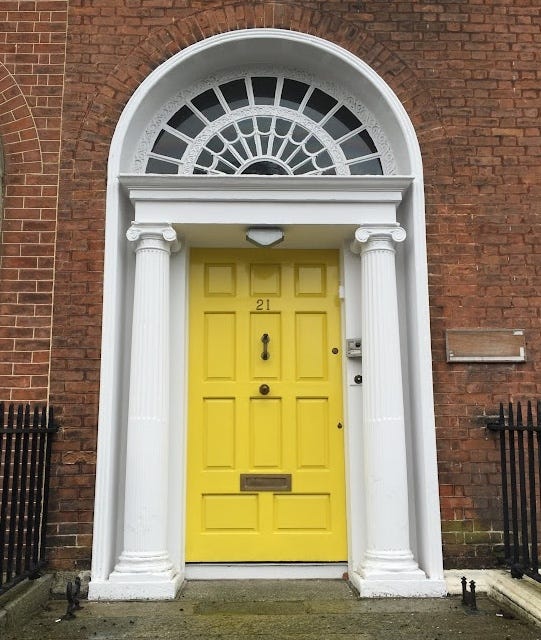Eee Mee Yah and Slack's International HQ
Europe calling, early. Familiarizing in Dublin. Landing in Ireland. Learning the lingo. Deciding on Dublin.
The alarm sounded. It was 5 am and dark, raining. Winter in Vancouver. Streetlights reflecting off wet pavement, off reflective windows.
I rolled out of bed and brushed my teeth, turned on my computer at the kitchen table to light the darkened room. Did I have time to make coffee before the call? I certainly did. I certainly needed it.
The German team I was set to meet with were interested and already using Slack. I was excited to speak with them and wanted to be ready with some specifics from their existing product use to help them. It always surprised folks when you showed up to a call with them ready to show them how they were already using Slack. I was surprised they were surprised by this (shouldn’t everyone they met with do this for them?), but it always worked well to move conversations ahead.
I started to pull together the usage stats and dig into the people actually using the product. I’d spend a few minutes on research and see if I could triangulate and inference who was using Slack and how they were using it. This rough research always made for better calls because it became about their specific uses of Slack, not some hypothetical, abstract, prospective ways of using Slack.
At 5:30 am I started the video call and they joined right on time. I can’t recall the name of the company or content of the call without going back to notes from that time, but this was representative. Folks were keen. That call could have been any Wednesday in October, November or December of 2014. The people on the other end of the video call could have as easily been in London or Oslo or Paris too. Europe was onto Slack and wanted to talk.
Batching up Europe
The reason I know the day of the week is because Wednesdays mornings were when I tried to batch up all the European calls so I only had one 5 am wake up per week. Those Wednesday morning hours quickly filled up and Thursdays started to host the spillover. Our customers in aggregate were pretty clearly telling us: we are global and need Slack to be global.
Around the same time, our leadership had been discussing the idea of opening an office in Europe. It came as a natural progression. I’d been focused on building our Accounts team in Vancouver, and AJ was focused on building an Accounts team in San Francisco. Maggie Hott joined in SF and we kept adding people pretty much as quickly as we could hire them. The company was clearly changing and growing in response to its success.
Then how did the conversation about opening in Europe start?
I have a fuzzy memory of Stewart stopping by my desk one day when he was back in Vancouver and asking if I’d heard we might be opening in Europe. Would I be open to going to Europe? I had not heard. I wasn’t sure. I’m sure I made some non-committal positive response, and I truly did have a non-committal positive outlook on it. Could I learn more?
That night I talked with my wife about my conversation with Stewart and she was noncommittally positive as well. We were interested. But we didn’t really know what we might be getting in to. We had a 1.5 year old son. We had questions. We’d always talked about living and working internationally. Europe seemed exotic yet safe. An adventure with supports. The opportunity hung in the air as an attractive option worth considering.
The idea started to gain momentum internally at the company too. It became something we certainly were going to do.
By February, 2015, I was on a plane with a handful of other folks — CFO, Allen Shim, Head of Customer Service, Ali Rayl and AJ — to Dublin for a familiarization trip. I had been to Europe twice before but never to Ireland. It was all so new.
We landed late in the evening after an all-day flight and found our way to the Shelbourne Hotel in the centre of Dublin. We went to bed in that haze of long flights and novelty, tiredness and excitement.
Dublin Familiarization
I woke the next morning to slanting sunshine and wet streets. The rain had just passed and the sun shone at an acute angle along the stone and brick buildings, casting long shadows from a passing cyclist onto empty streets in front of St. Stephen’s Green.
I could see 2 pubs from my window. Beyond, the low skyline of Dublin stretched away in repeating layers of peaked roofs and stone and brick and chimneys. So many chimneys topping the Edwardian architecture, remnants from days before central heating.
For the next 3 days we jammed in meetings, briefings, viewings. We crammed into cars between offices. We got out to restaurants. We loitered in lobbies and made small talk. We tried to absorb as much information as we could.
Our hosts were IDA Ireland, a government agency charged with attracted foreign direct investment. They ferried us around Dublin in an ever rotating series of cabs, each ride supported by the colourful perspectives of a Dublin taxi driver.
Our main shepherd was Kathleen Bohan. She was organized and bright and ran a tight ship. It felt like we had the IDA Ireland’s top man on the job, equally adept in the boardroom and the snug of a pub. Impeccably turned out for every occasion, Kathleen could advise on anything — office locations as well as schools for the kids. She seemed to have a taxi constantly at the end of a string and she just had to snap her fingers to get picked up.
We met accountants who wanted to work with us and set up Slack’s international business. We met bankers who treated us as important people and helped us set up private banking arrangements for easy landing and the safe deposit of euros. We met recruiters who wanted to supply us with people in sales and customer service roles. They showcased the CVs of keen Irish, Swedish, German, French, Spanish and English candidates ready to fill roles. It seemed the booming Irish tech scene had pulled in young and well educated people from all over the EU.
Learning the Lingo of Global Success
Over and over as we toured Dublin we heard stories of other US-based tech companies who had come, set up and succeeded: New Relic, LinkedIn, Indeed, Etsy, Airbnb. There was an established model to follow.
Facebook had 2,000 employees at The Docks and had just opened a new building that was already near full. Google had 3,500 employees just down the street and had an application to build a 10-storey building. Talk shows were full of outrage at the skyscraping audacity — for Dublin’s skyline that proposal constituted an office tower.
We learned a whole language of acronyms that we took a moment to become fluent in.
EMEA, pronounced ‘eee mee yah,’ for Europe, Middle East and Africa.
DACH, pronounced ‘datch’ or ‘datcha,’ for Germany, Austria and Switzerland.
BENELUX, pronounced ‘ben-uh-lex,’ for Belgium, Netherlands and Luxembourg.
MENA, pronounced ‘mee-nah,’ for Middle East, North Africa.
ROW, pronounced ‘arr-oh-dub-yoo,’ for Rest of World.
This was the insider language on how tech companies organized their markets, their marketing, their staffing, their international business. This was a hint to us of what was to come.
We learned about why Dublin (and Ireland) were the centre of the boom, rooted mostly in US-based tech companies like us. And let’s not mince words here, the first reason was taxes. Irish corporate taxes were low at 12%. The lowest in the EU. No one wanted to talk too much about this fact and it seemed plainly obvious and compelling, so we moved on and let the other factors become emphasized.
The Irish talent pool was large and well educated, a product of Ireland’s strong education system, its generous funding for Irish and EU students to study in Ireland (mostly for free) and a culture of high achievement in academics. Ireland was the only country in the EU that used the euro where English was the first language (sorry to any Irish speakers). The Irish global diaspora and openness and business connections all also helped and got rolled up into the idea of a warm and welcoming culture.
As other options, we also looked at opening our EMEA HQ in Amsterdam and London, but those inquiries were short and closed quickly. The models they had to show us were more complex and fewer in number. The path to success seemed less well established.
To make matters simpler, in Dublin we had a well trod path to follow, and it was a path we were keen to get started on. We could see the story consistently playing out right before our eyes — come and get set up, grow, hire, expand, succeed. Then open in London, Paris, Germany (the obvious location in Germany was never clear because some opted for edgy and techy Berlin, some opted for central and successful Frankfurt, some opted for powerful and staid Munich). Use Ireland as your international hub and then those other European offices as satellites.
Lastly, we looked quickly at some other Irish options in smaller cities like Galway or Cork. They were cheaper but harder to actually operate in. They were lovely but small and remote, with smaller workforces and fewer options. They could have been good options but they were not good options for us.
As we were just defining at the time, a Slack office anywhere in the world was to be central and located in a prestigous location, near an international airport. The office was as much a signal internally as it was externally of our ambitions and our priorities. We optimized for growth, status and success. We wanted people to know that. As an Irish friend would later say, we had notions.
Deciding on Dublin
After 3 days in Dublin we all flew home and I had a growing sense that I would be back and back to stay for much longer next time.
Had my wife and I already made the decision to go for it by then? I don’t think we had, officially. We hadn’t signed any paperwork. We hadn’t made any moves or initiated any logistical gymnastics.
But I remember we were on the path, and saying yes to going felt like a formality. We were well enough down the path that it would have taken something clearly negative to stop our momentum.
On my final day in Dublin I had driven around with Kathleen in a taxi looking at neighbourhoods. Without a car, where could we easily commute from, get groceries to, find entertainment around? Where could my son, at the time turning two, find climbing frames, swings, a pool, a crèche (which I learned was childcare)?
We swept along main streets and watched elegant brick Edwardian buildings pass by with their painted doors in canary yellow, rich navy, racing green, lipstick red. Embassies showed up with their national flags flying from flagpoles in the front: Brazil, Morocco, Portugal, Georgia, Nigeria.
We crossed and recrossed the canal and then the River Dodder, over the Balls Bridge in the neighbourhood of Ballsbridge. I told Kathleen a ‘donnybrook’ meant a fight or broo-hah-hah in Canada as we left the area known as Donnybrook, and she didn’t believe me. “You’re pulling me leg.”
Everywhere seemed signs of Dublin’s growing wealth and international population and own notions. Artisanal grocers on the corners between the Spar and the Aldi. Gyms open 24 hours. Coffee shops with incandescent bulbs in the front window and roasteries out back. Catering services and yoga studios and Indian takeaways and bike shops and pubs and pubs and pubs, almost all carrying a family name or a proprietor still working or a long-gone or once-imaged barman. Each pub seemed to occupy its own niche. Each pub familiar and the same — the Guinness, wood floors, chairs, tables, layout of bar stools and booths — and each pub its own niche and different, adjusting the knobs of class, sport and location to meet its patrons.
Dublin felt very much a city in the midst of a large, ongoing and permanent change. The history of the place remained. Its built infrastructure reflective of hundreds of years of humans making their lives. Its winding streets, lanes and alleys never centrally planned. Its brick and stone all showing the accumulated aspirations and plans of the people who had come before. Yet its transition also showing. Pubs opened for brunch on Sundays.
In a more uptight city the transition could have caused friction and much grinding of teeth about its meaning, its impact, its threat to a way of life. But not much of that noise sounded in Dublin, in the Irish Times, on RTE or the morning chat shows that charmingly filled their air time by reading the newspaper headlines.
The natural divide of River Liffey bisected the city into north and south sides and still showed some of the class divides of the past — the south rich, the north poor, the south educated, the north working class. The north hosted industrial parks and the airport, late night chippers and the sprawling zoo. Bereft urban islands of estates littered with burned out cars. The south hosted football fields and private schools with uniformed attendees marching forth to fill the growing professional classes. Watching the college rugby team or the Leinster machine. Churches and estate offices and betting shops sprouted up everywhere at the slightest intersection and didn’t discriminate based on the neighbourhood or class.
This was the Dublin we decided to move to in April, 2015, and where we would live until July, 2017. Twenty six months of our life, on a mission to bring Slack to EMEA from our International HQ in Dublin.
But I’m getting ahead of myself. Our family still had to pack up and leave!
Up next — Leaving for Dublin: Things left behind. Deciding as a family. Acknowledging the inequality of it all. Celebrating moving.


